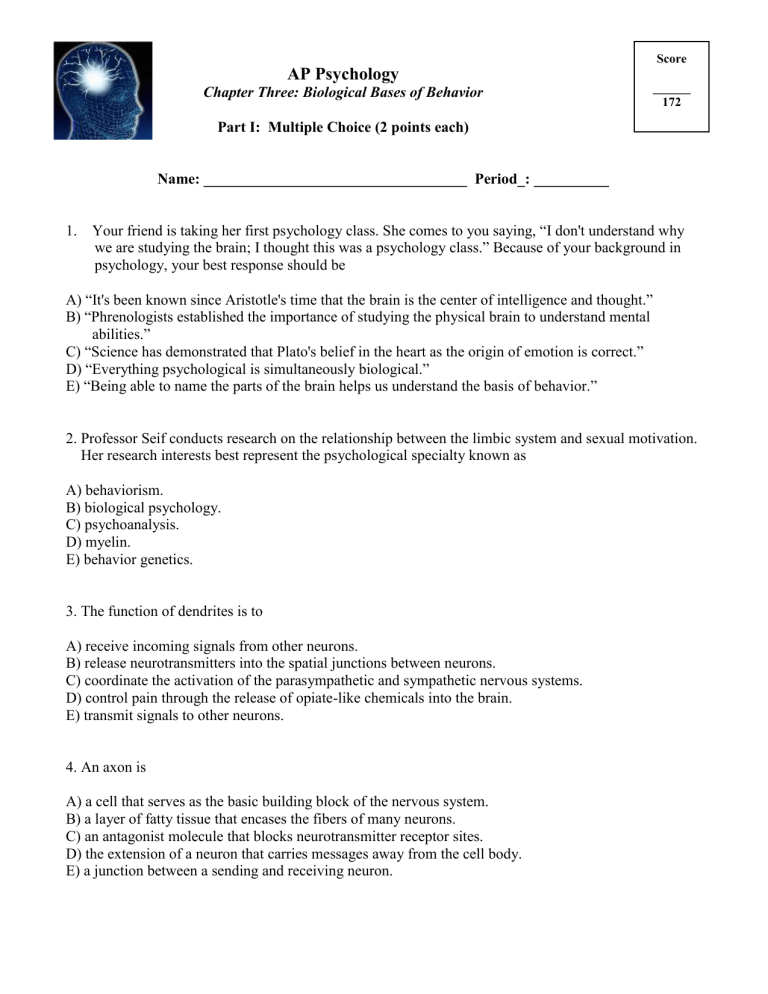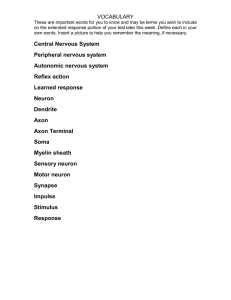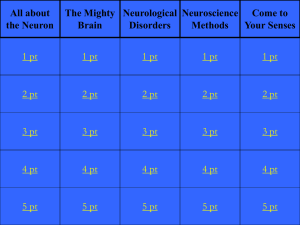AP Psychology Chapter 3 Test Multiple Choice Practice (1)
advertisement

AP Psychology Chapter Three: Biological Bases of Behavior Score ______ 172 Part I: Multiple Choice (2 points each) Name: ___________________________________ Period_: __________ 1. Your friend is taking her first psychology class. She comes to you saying, “I don't understand why we are studying the brain; I thought this was a psychology class.” Because of your background in psychology, your best response should be A) “It's been known since Aristotle's time that the brain is the center of intelligence and thought.” B) “Phrenologists established the importance of studying the physical brain to understand mental abilities.” C) “Science has demonstrated that Plato's belief in the heart as the origin of emotion is correct.” D) “Everything psychological is simultaneously biological.” E) “Being able to name the parts of the brain helps us understand the basis of behavior.” 2. Professor Seif conducts research on the relationship between the limbic system and sexual motivation. Her research interests best represent the psychological specialty known as A) behaviorism. B) biological psychology. C) psychoanalysis. D) myelin. E) behavior genetics. 3. The function of dendrites is to A) receive incoming signals from other neurons. B) release neurotransmitters into the spatial junctions between neurons. C) coordinate the activation of the parasympathetic and sympathetic nervous systems. D) control pain through the release of opiate-like chemicals into the brain. E) transmit signals to other neurons. 4. An axon is A) a cell that serves as the basic building block of the nervous system. B) a layer of fatty tissue that encases the fibers of many neurons. C) an antagonist molecule that blocks neurotransmitter receptor sites. D) the extension of a neuron that carries messages away from the cell body. E) a junction between a sending and receiving neuron. 5. In transmitting sensory information to the brain, an electrical signal travels from the ________ of a single neuron. A) cell body to the axon to the dendrites B) dendrites to the axon to the cell body C) axon to the cell body to the dendrites D) dendrites to the cell body to the axon E) axon to the dendrites to the cell body 6. A brief electrical charge that travels down the axon of a neuron is called the A) synapse. B) agonist. C) action potential. D) myelin sheath. E) refractory period. 7. As you are reading this question, the cells in your eyes are firing in response to the light coming from this paper. Which type of neuron is carrying this message to the brain? A) interneuron B) sensory C) presynaptic D) motor E) efferent 8. The axon of a resting neuron has gates that do not allow positive sodium ions to pass through the cell membrane. What is this characteristic called? A) myelin sheath B) threshold C) selective permeability D) action potential E) parasympathetic nervous system 9. A synapse is a(n) A) chemical messenger that triggers muscle contractions. B) automatic response to sensory input. C) neural network. D) junction between a sending neuron and a receiving neuron. E) neural cable containing many axons. 10. Sheelah was able to jerk her hand out of the scalding water before sensing any pain because this withdrawal reflex A) was activated by interneurons in her spinal cord. B) did not involve activity in her central nervous system. C) was activated by the rapidly responding brain. D) was activated by her self-regulating autonomic nervous system. E) was controlled by both her nervous system and impulses from her endocrine system. 11. Hormones are the chemical messengers of the A) action potential. B) autonomic nervous system. C) endocrine system. D) peripheral nervous system. E) central nervous system. 12. Prozac, a drug commonly prescribed to treat depression, prevents the sending neuron from taking in excess serotonin. Which process does this drug prevent from taking place? A) depolarization B) reuptake C) the all-or-none response D) an action potential E) a refractory period 13. Neural networks refer to A) the branching extensions of a neuron. B) interconnected clusters of neurons in the central nervous system. C) neural cables containing many axons. D) junctions between sending and receiving neurons. E) neurons that connect the central nervous system to the rest of the body. 14. When Mr. Valdez thought his 1-year-old daughter had fallen down the stairs, his heartbeat accelerated, his blood pressure rose, and he began to perspire heavily. Mr. Valdez's state of arousal was activated by his ________ nervous system. A) parasympathetic B) sympathetic C) somatic D) sensorimotor E) central 15. The somatic nervous system is a component of the ________ nervous system. A) peripheral B) autonomic C) central D) sympathetic E) parasympathetic 16. For you to experience the pain of a sprained ankle, ________ must first relay messages from your ankle to your central nervous system. A) endocrines B) interneurons C) glands D) motor neurons E) sensory neurons 17. The peripheral nervous system is to sensory neurons as the central nervous system is to A) motor neurons. B) neurotransmitters. C) interneurons. D) the sympathetic nervous system. E) the parasympathetic nervous system. 18. What are the molecules that are similar enough to a neurotransmitter to bind to its receptor sites on a dendrite and mimic that neurotransmitter's effects called? A) agonists B) antagonists C) endorphins D) endocrines E) action potentials 19. The body's speedy, electrochemical information system is called the A) circulatory system. B) threshold. C) action potential. D) nervous system. E) endocrine system. 20. An undersupply of serotonin is most closely linked to A) Alzheimer's disease. B) schizophrenia. C) Parkinson's disease. D) depression. E) euphoria. 21. When the release of ACh is blocked, the result is A) depression. B) muscular paralysis. C) aggression. D) schizophrenia. E) euphoria. 22. The master gland of the endocrine system is the A) thyroid gland. B) adrenal gland. C) pituitary gland. D) pancreas. E) hypothalamus. 23. The neural system located at the border between the brainstem and the cerebral hemispheres is known as the A) sensory cortex. B) limbic system. C) reticular formation. D) peripheral nervous system. E) cerebellum. 24. Which of the following is the component of the limbic system that plays an essential role in the processing of new memories? A) hypothalamus B) thalamus C) hippocampus D) medulla E) cerebellum 25. Which brain structure relays information from the eyes to the visual cortex? A) thalamus B) amygdala C) medulla D) hippocampus E) cerebellum 26. We are usually least consciously aware of the processes and functions of which brain structure? A) cerebral cortex B) motor cortex C) sensory cortex D) brainstem E) Broca's area 27. The “little brain” attached to the rear of the brainstem is called the A) limbic system. B) corpus callosum. C) cerebellum. D) reticular formation. E) thalamus. 28. Surgical destruction of brain tissue is called a(n) A) endorphin. B) EEG. C) synapse. D) lesion. E) MRI. 29. Your life would be most immediately threatened if you suffered destruction of the A) amygdala. B) hippocampus. C) angular gyrus. D) corpus callosum. E) medulla. 30. Which brain area is primarily involved with understanding and producing meaningful speech? A) sensory cortex B) angular gyrus C) association areas D) Wernicke's area E) hypothalamus 31. Opiate drugs occupy the same receptor sites as A) acetylcholine. B) serotonin. C) endorphins. D) dopamine. E) epinephrine. 32. The capacity of one brain area to take over the functions of another damaged brain area is known as brain A) tomography. B) phrenology. C) hemispherectomy. D) aphasia. E) plasticity. 33. What is the interdisciplinary study of how brain activity is linked with our mental processes called? A) social-cultural perspective B) psychodynamic perspective C) cognitive neuroscience D) industrial-organizational psychology E) biopsychosocial approach 34. Sleep researchers who are interested in brain wave activity are likely to use which kind of brain scan? A) EEG B) CT C) fMRI D) PET E) MRI 35. Information is most quickly transmitted from one cerebral hemisphere to the other by the A) medulla. B) corpus callosum. C) angular gyrus. D) limbic system. E) reticular formation. 36. Which endocrine gland regulates body growth? A) parathyroid B) adrenal C) thyroid D) pituitary E) pancreas 37. Which brain area is primarily involved with controlling speech? A) sensory cortex B) angular gyrus C) association areas D) Broca's area E) hypothalamus 38. The cortical regions that are not directly involved in sensory or motor functions are known as A) interneurons. B) Broca's area. C) frontal lobes. D) association areas. E) parietal lobes. 39. A PET scan of a patient looking at a photograph of a painting would most likely indicate high levels of activity in which brain structure? A) sensory cortex B) Broca's area C) corpus callosum D) occipital lobes E) frontal lobes 40. The thin surface layer of interconnected neural cells that covers the cerebrum is called the A) cerebellum. B) corpus callosum. C) reticular formation. D) cerebral cortex. E) sensory cortex. 41. An area at the rear of the frontal lobes that controls voluntary movements is called the A) angular gyrus. B) hypothalamus. C) motor cortex. D) reticular formation. E) frontal association area. 42. Which lobes of the brain receive the input that enables you to feel someone scratching your back? A) parietal B) temporal C) occipital D) frontal E) cerebral. 43. The secretions of the pituitary gland are most directly regulated by the A) reticular formation. B) hypothalamus. C) amygdala. D) cerebellum. E) thalamus. 44. The study of the relative power and limits of genetic and environmental influences on behavior and personality traits is known as A) molecular genetics. B) evolutionary psychology. C) behavior genetics. D) natural selection. E) genome research. 45. When people discuss the “nature vs. nurture” controversy, Nature refers to ________ and Nurture refers to ________. A) genes; heredity B) chromosomes; genetics C) biology; environment D) DNA; hormones E) thinking; behavior 46. Reuptake refers to the A) movement of neurotransmitter molecules across a synaptic gap. B) release of hormones into the bloodstream. C) inflow of positively charged ions through an axon membrane. D) reabsorption of excess neurotransmitter molecules by a sending neuron. E) the ending of the refractory period. 47. Women are most likely to be sexually attracted to men who seem A) shy and reserved. B) emotionally reactive and intense. C) interested in recreational sex. D) mature and affluent. E) extraverted and dependent. 48. The reproductive advantage enjoyed by organisms best suited to a particular environment is known as A) self-regulation. B) behavior genetics. C) natural selection. D) heritability. E) nurture. 49. Compared with women, men are ________ likely to sacrifice to gain sex and ________ likely to perceive warm responses as a sexual come-on. A) less; more B) more; less C) not; less D) more; more E) not; more 50. How do evolutionary psychologists explain why pregnant women from cultures across the world tend to avoid bitter, strongly flavored foods? A) Most cultures educate women about the dangers of certain foods on a developing fetus. B) Women and men have genetic differences in taste preferences. C) Bitter tastes can be an indication of foods toxic toward a developing baby, so this preference developed through natural selection. D) Pregnant women tend to associate with one another and they acquire similar food preferences through social conformity. E) Historical preferences toward or against certain tastes tend to change as cultures change. 51. Evolutionary psychologists emphasize that environmentally adaptive behaviors are those that have promoted A) reproductive success. B) personal happiness. C) cultural diversity. D) heritability. E) behavior genetics. 52. Evolutionary psychology studies the evolution of behavior and the mind using principles of A) humanism. B) behaviorism. C) naturalistic observation. D) natural selection. E) genome mapping. 53. Molecular behavior geneticists seek links between __________ and specific disorders. A) chromosomes B) proteins C) genes D) environment E) behavior 54. Heritability refers to the extent to which A) unrelated individuals share common genes. B) genetic mutations can be transmitted to one's offspring. C) trait differences among individuals are attributable to genetic variations. D) adult personality is determined by infant personality. E) nurture controls a trait rather than nature. 55. Many genes respond to environmental conditions, reacting to different environmental contexts in different ways. This characteristic of genes is called what? A) chromosomes B) genotype C) heritability D) self-regulation E) evolution 56. Why is it incorrect to say that 50 percent heritability of intelligence means that the cause of your intelligence is 50 percent genetic and 50 percent environmental? A) because heritability accounts for variations among people, not in specific individuals B) because nurture controls intelligence levels, not nature C) because unrelated individuals share common genes D) because genes are the basis for our behavior, environment has no impact E) because heritability increases as environments change 57. Twin studies suggest that a strong influence on emotional instability comes from A) genetic predispositions. B) the Y chromosome. C) natural selection. D) the X chromosome. E) mutation. 58. A segment of DNA capable of synthesizing a specific protein is called a A) gene. B) mutation. C) chromosome. D) hormone. E) neurotransmitter. 59. Identical twins originate from the fertilization of A) a single egg cell by a single sperm cell. B) two egg cells by a single sperm cell. C) a single egg cell by two sperm cells. D) two egg cells by two sperm cells. E) either two egg cells or two sperm cells. 60. A human sperm cell contains A) 23 chromosomes. B) 23 genes. C) 46 chromosomes. D) 46 genes. E) 92 DNA strands. 61. To demonstrate that brain stimulation can make a rat violently aggressive, a neuroscientist should electrically stimulate the rat's A) reticular formation. B) cerebellum. C) medulla. D) amygdala. E) thalamus. 62. An all-or-none response pattern is characteristic of the A) initiation of neural impulses. B) release of endorphins into the central nervous system. C) release of hormones into the bloodstream. D) activation of either the sympathetic or the parasympathetic system. E) excitation of the antagonistic hormonal system. Answer Key - AP Psychology Chapter 3 1. D 2. B 3. A 4. D 5. D 6. C 7. B 8. C 9. D 10. A 11. C 12. B 13. B 14. B 15. A 16. E 17. C 18. A 19. D 20. D 21. B 22. C 23. B 24. C 25. A 26. D 27. C 28. D 29. E 30. D 31. C 32. E 33. C 34. A 35. B 36. D 37. D 38. D 39. D 40. D 41. C 42. A 43. B 44. C 45. C 46. D 47. D 48. C 49. D 50. C 51. A 52. D 53. C 54. C 55. D 56. A 57. A 58. A 59. A 60. A 61. D 62. A





